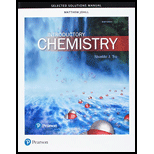
Interpretation:
For each atom in the given polyatomic ion or, the oxidation state is to be assigned.
Concept information:
The oxidation state of a substance is defined as the transfer of electrons in a chemical compound or as a charge which an atom of the element has in its ion or appears to have when present in the combined state with other atoms.
It can either be zero, positive or negative. An atom which gains electron has a negative value of oxidation state and atom which loses has a positive oxidation state.
The oxidation state of a monatomic ion is equal to the charge on the ion.
The oxidation state of an atom in Free State is zero.
Each group possess a particular oxidation state. The oxidation state of group I is
In the compounds, the overall oxidation state of a neutral atom is zero.
In complex ions, the sum of oxidation numbers of all atoms in the ions is equal to the charge on the ion.
Want to see the full answer?
Check out a sample textbook solution
Chapter 16 Solutions
Introductory Chemistry-Selected Solution Manual
- Chromium has been investigated as a coating for steel cans. The thickness of the chromium film is determined by dissolving a sample of a can in acid and oxidizing the resulting Cr3+ to Cr2O72 with the peroxydisulfate ion: S2O82(aq) + Cr3+(aq) + H2O(l) Cr2O72(aq) + SO42(aq) + H+(aq) (Unbalanced) After removal of unreacted S2O82 an excess of ferrous ammonium sulfate [Fe(NH4)2(SO4)26H2O] is added, reacting with Cr2O72 produced from the first reaction. The unreacted Fe2+ from the excess ferrous ammonium sulfate is titrated with a separate K2Cr2O7 solution. The reaction is: H+(aq) + Fe2+(aq) + Cr2O72(aq) Fe3+(aq) + Cr3+(aq) + H2O(l) (Unbalanced) a. Write balanced chemical equations for the two reactions. b. In one analysis, a 40.0-cm2 sample of a chromium-plated can was treated according to this procedure. After dissolution and removal of excess S2O82, 3.000 g of Fe(NH4)2(SO4)26H2O was added. It took 8.58 mL of 0.0520 M K2Cr2O7 solution to completely react with the excess Fe2+. Calculate the thickness of the chromium film on the can. (The density of chromium is 7.19 g/cm3)arrow_forwardThe Toliens test for the presence of reducing sugars (say, in a urine sample) involves treating the sample with silver ions in aqueous ammonia. The result is the formation of a silver mirror within the reaction vessel if a reducing sugar is present. Using glucose, C6H12O6, to illustrate this test, the oxidation-reduction reaction occurring is C6H12O6 (aq) + 2 Ag+(aq) + 2OH(aq) C6H12O7(aq) + 2 Ag(s) + H2O() What has been oxidized, and what has been reduced? What is the oxidizing agent, and what is the reducing agent? Tolien's test. The reaction of silver ions with a sugar such as glucose produces metallic silver. (a) The set-up for the reaction. (b) The silvered test tubearrow_forwardGold can be dissolved from gold-bearing rock by treating the rock with sodium cyanide in the presence of oxygen. 4 Au(s) + 8 NaCN(aq) + O2(g) + 2 H2O() 4 NaAu(CN)2(aq) + 4 NaOH(aq) (a) Name the oxidizing and reducing agents in this reaction. What has been oxidized, and what has been reduced? (b) If you have exactly one metric ton (1 metric ton = 1000 kg) of gold-bearing rock, what volume of 0.075 M NaCN, in liters, do you need to extract the gold if the rock is 0.019% gold?arrow_forward
- The blood alcohol (C2H5OH) level can be determined by titrating a sample of blood plasma with an acidic potassium di-chromate solution, resulting in the production of Cr3+ (aq) and carbon dioxide. The reaction can be monitored because the dichromate ion (Cr2O72) is orange in solution, and the Cr3+ ion is green. The balanced equations is 16H+(aq) + 2Cr2O72(aq) + C2H5OH(aq) 4Cr4+(aq) + 2CO2(g) + 11H2O(l) This reaction is an oxidationreduction reaction. What species is reduced, and what species is oxidized? How many electrons are transferred in the balanced equation above?arrow_forwardComplete and balance the following oxidation-reduction reactions, which give the highest possible oxidation state for the oxidized atoms. (a) Al(s)+F2(g) (b) Al(s)+CuBr2(aq) (single displacement) (c) P4(s)+O2(g) (d) Ca(s)+H2O(l) (products are a strong base and a diatomic gas)arrow_forwardFour metals, A, B, C, and D, exhibit the following properties: (a) Only A and C react with 1.0 M hydrochloric acid to give H2(g). (b) When C is added to solutions of the ions of the other metals, metallic B, D, and A are formed. (c) Metal D reduces Bn+ to give metallic B and Dn+. Based on this information, arrange the four metals in order of increasing ability to act as reducing agents.arrow_forward
 Introductory Chemistry: A FoundationChemistryISBN:9781337399425Author:Steven S. Zumdahl, Donald J. DeCostePublisher:Cengage Learning
Introductory Chemistry: A FoundationChemistryISBN:9781337399425Author:Steven S. Zumdahl, Donald J. DeCostePublisher:Cengage Learning Chemistry: The Molecular ScienceChemistryISBN:9781285199047Author:John W. Moore, Conrad L. StanitskiPublisher:Cengage Learning
Chemistry: The Molecular ScienceChemistryISBN:9781285199047Author:John W. Moore, Conrad L. StanitskiPublisher:Cengage Learning ChemistryChemistryISBN:9781305957404Author:Steven S. Zumdahl, Susan A. Zumdahl, Donald J. DeCostePublisher:Cengage Learning
ChemistryChemistryISBN:9781305957404Author:Steven S. Zumdahl, Susan A. Zumdahl, Donald J. DeCostePublisher:Cengage Learning Chemistry by OpenStax (2015-05-04)ChemistryISBN:9781938168390Author:Klaus Theopold, Richard H Langley, Paul Flowers, William R. Robinson, Mark BlaserPublisher:OpenStax
Chemistry by OpenStax (2015-05-04)ChemistryISBN:9781938168390Author:Klaus Theopold, Richard H Langley, Paul Flowers, William R. Robinson, Mark BlaserPublisher:OpenStax World of Chemistry, 3rd editionChemistryISBN:9781133109655Author:Steven S. Zumdahl, Susan L. Zumdahl, Donald J. DeCostePublisher:Brooks / Cole / Cengage Learning
World of Chemistry, 3rd editionChemistryISBN:9781133109655Author:Steven S. Zumdahl, Susan L. Zumdahl, Donald J. DeCostePublisher:Brooks / Cole / Cengage Learning Chemistry & Chemical ReactivityChemistryISBN:9781133949640Author:John C. Kotz, Paul M. Treichel, John Townsend, David TreichelPublisher:Cengage Learning
Chemistry & Chemical ReactivityChemistryISBN:9781133949640Author:John C. Kotz, Paul M. Treichel, John Townsend, David TreichelPublisher:Cengage Learning





